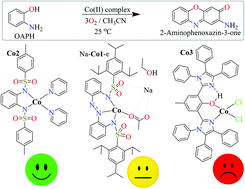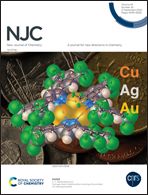New cobalt(ii) coordination designs and the influence of varying chelate characters, ligand charges and incorporated group I metal ions on enzyme-like oxidative coupling activity†
Abstract
In transition-metal-mediated catalysis, designing new, well defined coordination architectures and subjecting them to catalysis testing under the same reaction conditions is a necessary tool for gaining an improved understanding of desirable active site geometries and characteristics. In this work, three ligands varying in chelation and charge characters (1 = tridentate, dianionic N^N^N; 2 = bidentate, dianionic N^N; 3 = bidentate, neutral N^O) were synthesized and introduced as organic backbones around cobalt(II) centres. Four multinuclear coordination assemblies incorporating various group I metal ions (i.e., (Na-Co1-i)2, (Na-Co1-e)2, (K-Co1-e)2 and (Cs-Co1-e)2) and two mononuclear complexes (i.e., Co2 and Co3) were isolated, structurally characterized and studied as phenoxazinone synthase models. X-ray data and Continuous Shape Measure (CShM) calculations described unusual vacant trigonal bipyramidal geometries for (Na-Co1-i)2, (Na-Co1-e)2 and Co3, trigonal bipyramids for (K-Co1-e)2 and (Cs-Co1-e)2, and a tetrahedron for Co2. According to mass spectrometry data, the four multinuclear (MI-Co1-solvate)2 complexes of ligand 1 easily dissociate in solution to yield the corresponding ions including a common mononuclear Co1 unit. Testing as models in the oxidative coupling of o-aminophenol revealed that an increasing chelate character of the organic ligand backbone produces an undesirable catalyst activity reduction. Furthermore, the similarity in coupling efficiencies observed among complexes (Na-Co1-i)2, (Na-Co1-e)2, (K-Co1-e)2 and (Cs-Co1-e)2 proves that the presence of varying group I metal ions contributed no catalytic effects to the coupling efficiencies and that the Co1 species, which is generated by dissociation in solution, is the only active species responsible for the observed biomimetic behaviours. Therefore, the combination of anionic chelate ligands with easily detachable, neutral co-ligands (e.g., water or pyridine) around a cobalt(II) centre could be recommended for the generation of a successful catalyst material, rather than the combination of a neutral chelate ligand with counter-anionic monodentate co-ligands like halides.



 Please wait while we load your content...
Please wait while we load your content...